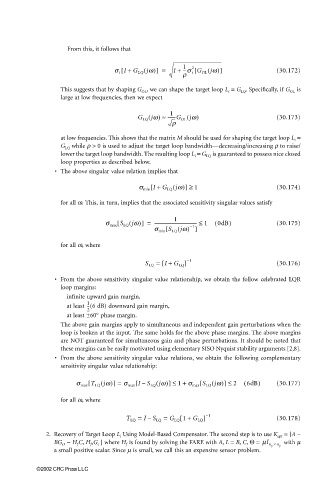Page 919 - The Mechatronics Handbook
P. 919
0066_Frame_C30 Page 30 Thursday, January 10, 2002 4:44 PM
From this, it follows that
1
[
(
2
s i I + G LQ jw)] = I + ---s i G OL jw([ )] (30.172)
r
This suggests that by shaping G OL , we can shape the target loop L i = G LQ . Specifically, if G OL is
large at low frequencies, then we expect
1
G LQ jw) ≈ -------G OL jw( ) (30.173)
(
r
at low frequencies. This shows that the matrix M should be used for shaping the target loop L i =
G LQ while r > 0 is used to adjust the target loop bandwidth—decreasing/increasing r to raise/
lower the target loop bandwidth. The resulting loop L i = G LQ is guaranteed to possess nice closed
loop properties as described below.
• The above singular value relation implies that
(
[
s min I + G LQ jw)] ≥ 1 (30.174)
for all ω. This, in turn, implies that the associated sensitivity singular values satisfy
1
[
s max S LQ jw)] = -------------------------------------- ≤ 1 ( 0dB) (30.175)
(
s min S LQ jw) ]
[
(
−1
for all ω, where
S LQ = [ I + G LQ ] −1 (30.176)
• From the above sensitivity singular value relationship, we obtain the follow celebrated LQR
loop margins:
infinite upward gain margin,
1
at least (6 dB) downward gain margin,
--
2
at least ±60° phase margin.
The above gain margins apply to simultaneous and independent gain perturbations when the
loop is broken at the input. The same holds for the above phase margins. The above margins
are NOT guaranteed for simultaneous gain and phase perturbations. It should be noted that
these margins can be easily motivated using elementary SISO Nyquist stability arguments [2,8].
• From the above sensitivity singular value relations, we obtain the following complementary
sensitivity singular value relationship:
(
[
(
(
[
s max T LQ jw)] = s max IS LQ jw)] ≤ 1 + s max S LQ jw)] ≤ 2 ( 6dB) (30.177)
[
–
for all w, where
T LQ = IS LQ = G LQ 1 + G LQ ] −1 (30.178)
[
–
2. Recovery of Target Loop L i Using Model-Based Compensator. The second step is to use K opt = [A −
with µ
BG c , − H f C, H f ,G c ] where H f is found by solving the FARE with A, L = B, C, Θ = mI n × n
y y
a small positive scalar. Since m is small, we call this an expensive sensor problem.
©2002 CRC Press LLC

